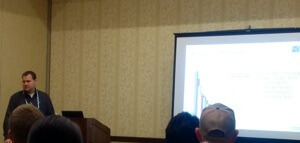 Emerson’s Mikael Helmer provided an update on modern tank gauging systems and reasons to upgrade from existing ones. His abstract:
Emerson’s Mikael Helmer provided an update on modern tank gauging systems and reasons to upgrade from existing ones. His abstract:
The industry trend is clear, and have been so for a number of years. New radar based tank gauging systems are becoming the industry standard. But how does it fit into my existing infrastructure, and how and where do I install it and to what extent are new tank openings required? What if I have an existing system, can it work together? If I decide to do this, what benefits will this upgrade provide compared with my existing system? This presentation will give you examples and best practices recommendations of how and why to install a new radar tank gauging system.
He described the challenge of many installations with aging and obsolete tank gauging instrumentation, cabling, and installation infrastructure. The biggest consideration for upgrading is that every drop in the tank counts, especially today with the price of crude oil over $100 / barrel.
Volume accuracy provides savings given the volumes associated with larger tanks. Regulations also specify accuracy levels such as OIML and their requirements for custody transfer. Tank safety and overspill prevention remain at the top of key concerns where accurate level measurement is required.
Mikael highlighted numerous standards around automatic tank gauging, LPG measurements, hybrid measurements, and overfill protections based on the American Petroleum Institute (API) and other standards bodies.
Tanks require measurements for net volume, net volume draining, density, and overfill safety. Technologies include radar gauge, temperature transmitters, pressure sensors for measurement. The Rosemount 5900S Raptor gauge exceeds the OIML R85:2008 international custody transfer standard.
The tanking gauging system is certified for safety applications up to SIL 3. Mikael described the 2-in1 concept where two independent and continuous radar level measurements in a single radar level device. This has many applications including tanks with only one opening and redundant measurements.
Improvements have been made overtime from multiple wires into the device for level, temperature, etc. to a single pair of wires and digital communications.
Mikael gave guidance where the tank gauging and other measurement should be installed. One example is for fixed roofs, the guided wave radar measurement should be near the wall, since often their is flex towards the middle of tank roof. The accuracy of the measurement is impacted by the flex in the roof.
Wireless tank radar measurement devices are ideal for tank farms. Because they site on the roof tops of tanks they have clear communications paths to each other to establish a robust, multi-path IEC 62591 wireless network.
